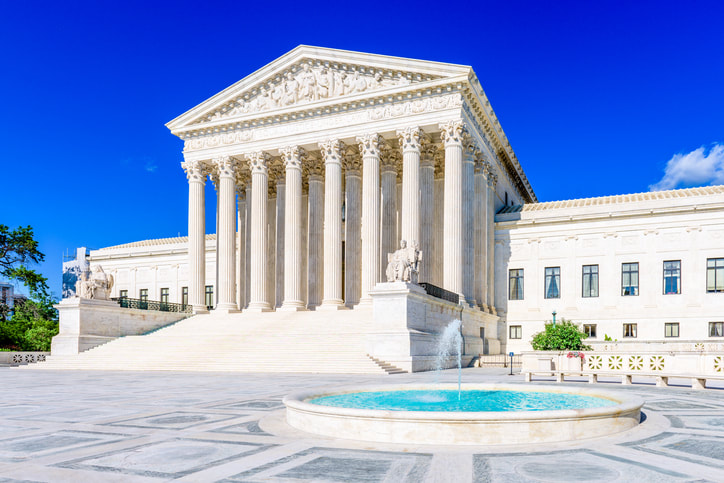On Tuesday, June 26, 2018, the Supreme Court of the United States upheld Trump’s controversial travel ban. The Supreme Court ruling in Trump v. Hawaii was divided 5-4 along partisan lines, with conservative justices in the majority and liberal justices in the dissenting minority. To read a copy of the entire opinion, click here.
In September 2017, President Trump issued Presidential Proclamation 9645 (the THIRD iteration of this idea), which has become known as the “travel or Muslim ban”. This Proclamation restricted immigration (to varying degrees) into the U.S. by citizens of seven different countries. Most of these countries (but not all of them) have predominantly Muslim populations. These seven countries are Iran, North Korea, Syria, Libya, Yemen, Somalia and Venezuela. Chad was initially on the list of countries subject to the travel ban, but it was recently removed after it met baseline security requirements.
The state of Hawaii argued that this September 2017 Presidential Proclamation exceeded the President’s authority under both federal immigration law and the U.S. Constitution. Hawaii also argued that the travel ban was discriminatory based on both religion and nationality. The state of Hawaii asked the Supreme Court to consider Trump’s speeches as well as his Twitter posts during his presidential campaign, with lawyers for Hawaii arguing that this rhetoric showed Trump’s desire to keep Muslims out of the U.S.
So why did the Supreme Court side with Trump? Chief Justice Roberts, who wrote the majority opinion, rejected Hawaii’s constitutional challenges to the September 2017 Presidential Proclamation. Chief Justice Roberts endorsed a broad view of presidential power, declaring that “The Proclamation is squarely within the scope of Presidential authority.” This is true, relying on an ancient provision in immigration law, created in 1940, as part of The Alien Act, and was used as a basis for denying visas to specific countries on national security grounds. The Supreme Court held that the permanent entry restrictions for the seven terror-prone countries is consistent with the U.S. Constitution’s Establishment Clause and Congress’s Immigration and Nationality Act.
The court rejected the plaintiff’s argument that the travel ban was based on religious hostility. In the majority opinion, Chief Justice Roberts writes that the September 2017 Presidential Proclamation is “expressly premised on legitimate purposes: preventing entry of nationals who cannot be adequately vetted and inducing other nations to improve their practice” and that the “text says nothing about religion.”
In a scathing, impassioned dissent, Justice Sotomayor compared the Supreme Court’s ruling in Trump v. Hawaii to the Supreme Court’s decision in the 1945 case of Korematsu v. United States, where the Court upheld the holding of Japanese-Americans in internment camps during World War II. Justice Sotomayor wrote that the Court’s decision fails to safeguard our Founder’s core promise that the United States of America is a nation build upon the promise of religious liberty. Sotomayor writes that, “Based on the evidence in the record, a reasonable observer would conclude that the Proclamation was motivated by anti-Muslim animus. That alone suffices to show that plaintiffs are likely to succeed on the merits of their Establishment Clause claim. The majority holds otherwise by ignoring the facts, misconstruing our legal precedent, and turning a blind eye to the pain and suffering the Proclamation inflicts upon countless families and individuals, many of whom are United States citizens. Because that troubling result runs contrary to the Constitution and our precedent, I dissent.”
The Supreme Court’s decision in Hawaii v. Trump is considered a big win for the Trump White House. In reaction to this decision, protests have sprung up on the streets across the country. Some Democrats are already calling for Congress to overturn the decision. A lawyer for the American Civil Liberties Union, which challenged the travel ban, said, “The ruling will go down in history as one of the Supreme Court’s great failures.” California’s Attorney General, Xavier Becerra, tweeted in response to the decision, “#SCOTUS got this one wrong. One day this nation & court will look back and regret this ruling that legalized discrimination.”
What are the implications of this decision? As of now, the restrictions set forth in the September 2017 Presidential Proclamation 9645 will remain in place for the indefinite future. Also, additional countries may be added or removed from the list. For more specific information about the restrictions in the Presidential Proclamation, check out the U.S. Department of State website.
This Presidential Proclamation/travel ban has already and will continue to cause chaos for affected individuals and their families. If you are concerned about how the travel ban will affect you or your family’s ability to travel, immigration status, student visa, work visa, and etc., it is strongly encouraged that you seek out knowledgeable, experienced immigration law help. Attempting to navigate and challenge the ever-changing immigration laws and policies without a professional immigration attorney by your side is extremely difficult.
- https://www.cnn.com/2018/06/26/politics/travel-ban-supreme-court/index.html
- https://www.cnn.com/2018/06/26/politics/travel-ban-supreme-court/index.html
- http://www.breitbart.com/big-government/2018/06/26/supreme-courts-historic-immigration-decision-in-trump-v-hawaii/
- https://www.cnbc.com/2018/06/26/supreme-court-rules-in-trump-muslim-travel-ban-case.html
- https://www.supremecourt.gov/opinions/17pdf/17-965_h315.pdf
- http://www.sandiegouniontribune.com/opinion/the-conversation/sd-supreme-court-upholds-trump-travel-ban-20180626-htmlstory.html


 RSS Feed
RSS Feed
